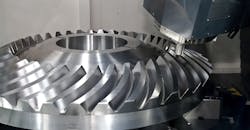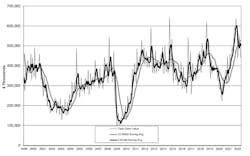US Machine Tool New Orders Drop Again
Machine shops and other domestic manufacturers ordered $441.2 million worth of new machine tools during May, -13.7% versus the April new order total and essentially even (-0.9%) with the order total for May 2021. May is the third straight month for declining new-order values and the lowest monthly order value since January.
Even so, the value of new orders during the first five months of 2022 is up to $2.42 billion, 20.4% higher than the January-May 2021 new-order total.
Purchasing activity began to improve considerably during the second quarter of 2021, as manufacturers rebounded from 2020 and began to respond to pent-up industrial demand. According to AMT-the Assn. for Manufacturing Technology, starting in May 2021 the average number of new machines ordered per month and the corresponding values have been in the top 25% of the history of the data series.
Data for new orders of machine tools, or manufacturing technology, is compiled by AMT and published monthly in the U.S. Manufacturing Technology Orders Report. The nationwide and regional data for metal-cutting and metal-forming and -fabricating machinery is presented in actual dollar values – and serves as a forward-looking indicator of overall manufacturing activity, as machine shops and other manufacturers make capital investments in preparation for demand expected in the weeks and months ahead.“Order activity has begun to moderate, but given the slight decline from record heights, 2022 is shaping up to be one of the best years over the last two decades,” explained AMT’s chief knowledge Pat McGibbon. “In any other year, numbers like we saw in May 2022 would be one of the high points, but after the run we’ve seen the previous 12 months, the monthly change is more of a return to normal than a dramatic pullback.”
McGibbon noted that at “modest signs of inflation” have started to be relevant in the pricing of manufacturing technology, but a more important factor in the rising average value of new units has been the cost of automation as a percentage of the total order.
“Difficulties filling vacancies over the past several months, concern over rising materials prices, and continued conflict in Europe have increased risk aversion among customers, leading to more cautious capital investment decisions,” according to the AMT executive.
“The impact of the pandemic on supply chains led to the reinvestment in industries that were nearly shuttered by imports. Industries like the manufacture of mold and dies, fabricated metal products, screws, and hardware have made expanded capacity well beyond their pre-pandemic levels,” McGibbon noted.
“In addition to securing supply chains from public health disruptions, there may be a renewed push to further reshore production, given the recent dangers to intellectual property outlined by the U.S. and U.K. intelligence agencies.”
The USMTO regional results for May showed improvement only in the North Central-East region, where new orders totaled $120.95 million, 4.2% higher than the April figure. Each of the other five regions posted new-orders from -6.5% (Southeast region) to -34.9% (South Central region) less than their comparable April results.

